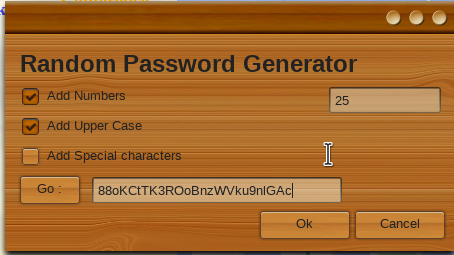I have created my first video in a series of planned videos on programming in QooxDoo.
Programming in QooxDoo:
QooxDoo is a object oriented JavaScript library which allows you to create any type of widget, like List controls, Tree controls, Windows etc. Inside the browser without the need to worry about browser compatibility.
Aside from being very easy to use, this framework is fully object oriented and is better than any other framework I have seen in the past. Obviously people have their own preferences, and frameworks like jQuery, and Angular are at the top of their game. QooxDoo like other frameworks has strong parts and its weak parts.
This episode goes through some basics first before I dive into the programming part. As mentioned above I create a random password generator which you can use whenever you are asked to either create a new password or re-new your old password.
You can find the video on YouTube.

The resulting application looks like this
What I have learned from my first video tutorial:
I found that my mic is too sensitive to the higher frequency ranges and going forward I will have to either find a hardware equalizer or do some post production on the audio in software.
Since I am using Linux, my setup is all open source and freely available. As such some of the shortcomings are that Audacity is crashing once in a while, KDenlive was constantly crashing and unusable so I had to switch to OpenShot. I may give Blender’s built in NLE ( Non Linear Video Editor ) a go in a future part.
My keyboard ‘hacking’ is way to loud and will either need to find another keyboard, try to get the right filter settings to suppress it as much as possible ( without too affecting the overall audio quality too much ) or place my mic in a better spot.
Bottom line:
I had a lot of fun putting this tutorial together. I spent probably twice as much time on getting my equipment in place, and preparing AstraNOS for the link to allow people to try for themselves Here …..
The next episode will take most likely less time overall and I will also try my best to cut down the duration of the next episode to be 10 minutes or less.
I learned a ton of things and I am going to continue to learn during my next videos.

